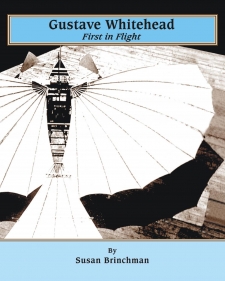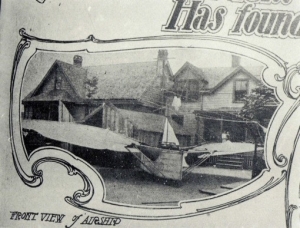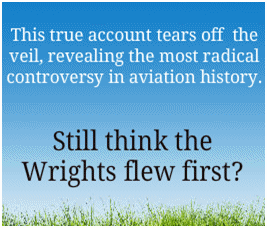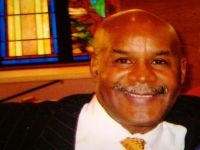
Gustave Whitehead: First in Flight, by Susan O’Dwyer Brinchman (Apex Educational Media, La Mesa, CA, 2015, 432 pages).
Book Review by Dennis Moore
July 23, 2015 (San Diego’s East County) - I was absolutely astounded and flabbergasted after reading Susan Brinchman’s Gustave Whitehead: First in Flight, for all my life and throughout elementary school and into college I had been taught that the Wright brothers, Orville and Wilbur, were the pioneers of modern aviation. In this fascinating and well documented and researched book, Brinchman states: “Paul Jackson, Editor-in-Chief of the century-old Jane’s All the World Aircraft (2013), often referred to as ‘the bible of aviation history’, announced in its Centennial Issue, in March, 2013, that Whitehead was ‘first to fly’, ahead of the Wrights, and was the inventor of the airplane, based on the mountainous evidence accumulated over the previous eight decades.”
 This La Mesa, California resident, Brinchman, is uniquely suited to present documentation concerning Gustave Whitehead. She has been intimately involved with Whitehead research for the past five decades; interacted with many of the previous researchers, was present for some interviews with witnesses, and as a native of Fairfield, CT, where these first flights occurred, is familiar with the places Whitehead lived and flew.
This La Mesa, California resident, Brinchman, is uniquely suited to present documentation concerning Gustave Whitehead. She has been intimately involved with Whitehead research for the past five decades; interacted with many of the previous researchers, was present for some interviews with witnesses, and as a native of Fairfield, CT, where these first flights occurred, is familiar with the places Whitehead lived and flew.
The author presents stunning new discoveries, solidifying the case for recognition of Gustave Whitehead as the “True Inventor of the Airplane” and “First in Powered Flight.” Ironically, it comes at a time when a book by David McCullough, The Wright Brothers (Simon & Shuster), is #1 on the New York Times Bestseller’s list. It really makes you wonder if The Wright Brothers were #1 on the New York Times Bestseller’s List, with the revelations and documentation by Brinchman in Gustave Whitehead: First in Flight, what does it say for this book?
 The author frames her very compelling book and story as the “Hidden History of Gustave Whitehead & the Wrights”, and reveals in this book little known facts about the first flights of Whitehead and the Wright brothers that will change perceptions about early aviation history, forever. She speaks of conspiracy theories. When I say initially that I was absolutely astounded and flabbergasted after reading Brinchman’s book, the details and research she provides in this book will convince others as well. She categorically states, and with conviction: “Connecticut aviation pioneer Gustave Whitehead invented and flew powered aeroplanes in 1901, over two years before the Wright brothers’ flights at Kitty Hawk.
The author frames her very compelling book and story as the “Hidden History of Gustave Whitehead & the Wrights”, and reveals in this book little known facts about the first flights of Whitehead and the Wright brothers that will change perceptions about early aviation history, forever. She speaks of conspiracy theories. When I say initially that I was absolutely astounded and flabbergasted after reading Brinchman’s book, the details and research she provides in this book will convince others as well. She categorically states, and with conviction: “Connecticut aviation pioneer Gustave Whitehead invented and flew powered aeroplanes in 1901, over two years before the Wright brothers’ flights at Kitty Hawk.
 Gustave Whitehead: First in Flight, is bound to raise a lot of controversy, but Brinchman provides in this book documentation and unimpeachable evidence and eyewitness accounts to counter that. This is a stunning book, that shakes my very core. It reads like a mystery novel, or spy and espionage story by Robert Ludlum. Everything that I had been taught as a child in grammar school and throughout college about the history of aviation and the Wright brothers, has now been turned upon its head. Brinchman has convinced me! There are conspiracies and coverups that one would not expect from something as historic as the evolution of flight.
Gustave Whitehead: First in Flight, is bound to raise a lot of controversy, but Brinchman provides in this book documentation and unimpeachable evidence and eyewitness accounts to counter that. This is a stunning book, that shakes my very core. It reads like a mystery novel, or spy and espionage story by Robert Ludlum. Everything that I had been taught as a child in grammar school and throughout college about the history of aviation and the Wright brothers, has now been turned upon its head. Brinchman has convinced me! There are conspiracies and coverups that one would not expect from something as historic as the evolution of flight.
 Brinchman, actually has a vested interest in this book and story, as her father, Major William J. O’Dwyer discovered in 1963 photographs of a Whitehead aeroplane taken on the grounds of the Brooklawn Country Club Fairway, on the border of Fairfield and Bridgeport, Connecticut. For over half a century Brinchman continued the quest of her father, to place Gustave Whitehead in his rightful place, that of First in Flight, before the Wright brothers. It is clear from the history books that Orville and Wilbur Wright made that famous flight at Kitty Hawk, but the author would have you to believe by countless eyewitness accounts and sworn affidavits that Gustave Whitehead made the first flight two years earlier, in 1901.
Brinchman, actually has a vested interest in this book and story, as her father, Major William J. O’Dwyer discovered in 1963 photographs of a Whitehead aeroplane taken on the grounds of the Brooklawn Country Club Fairway, on the border of Fairfield and Bridgeport, Connecticut. For over half a century Brinchman continued the quest of her father, to place Gustave Whitehead in his rightful place, that of First in Flight, before the Wright brothers. It is clear from the history books that Orville and Wilbur Wright made that famous flight at Kitty Hawk, but the author would have you to believe by countless eyewitness accounts and sworn affidavits that Gustave Whitehead made the first flight two years earlier, in 1901.
 Proof of the flights by Gustave Whitehead was abundant, even in the 1960’s. Resistance to the information by the Smithsonian was strong and hard to fathom – that is, until “the Contract” with Orville Wright’s heirs was unearthed by Maj. O’Dwyer in 1976, with the assistance of Senator Lowell Weicker, Jr. (later, Governor), of CT, published in “History by Contract” (O’Dwyer and Randolph, 1978). The “Smithsonian-Wright Agreement of 1948”, between the Wright executors and the United States of America, stipulated that the Smithsonian Institution would purchase the original Wright Flyer for $1 and other considerations, but neither the venerable Smithsonian Institution or its near-200 affiliated museums and research facilities could recognize any other airplane or person as “first in flight”, or the Wright Flyer would revert to the heirs. This “Contract” as it came to be called, finally explained the extreme reactions that had been seen to documentation of Whitehead’s successful flights by Smithsonian officials and their agents. This agreement is still in place, legally, today, so says Brinchman. Not until 2014, during the research conducted for this book, however, did it become known that those who crafted the required labels for the Wright Flyer crediting Orville were the same friends of Orville Wright who had worked together for nine years to disparage Whitehead as “first in flight”. We have, unfortunately, received an incomplete and some think, misleading history of first flight and early aviation, so says Brinchman. Thus, the conspiracy theory!
Proof of the flights by Gustave Whitehead was abundant, even in the 1960’s. Resistance to the information by the Smithsonian was strong and hard to fathom – that is, until “the Contract” with Orville Wright’s heirs was unearthed by Maj. O’Dwyer in 1976, with the assistance of Senator Lowell Weicker, Jr. (later, Governor), of CT, published in “History by Contract” (O’Dwyer and Randolph, 1978). The “Smithsonian-Wright Agreement of 1948”, between the Wright executors and the United States of America, stipulated that the Smithsonian Institution would purchase the original Wright Flyer for $1 and other considerations, but neither the venerable Smithsonian Institution or its near-200 affiliated museums and research facilities could recognize any other airplane or person as “first in flight”, or the Wright Flyer would revert to the heirs. This “Contract” as it came to be called, finally explained the extreme reactions that had been seen to documentation of Whitehead’s successful flights by Smithsonian officials and their agents. This agreement is still in place, legally, today, so says Brinchman. Not until 2014, during the research conducted for this book, however, did it become known that those who crafted the required labels for the Wright Flyer crediting Orville were the same friends of Orville Wright who had worked together for nine years to disparage Whitehead as “first in flight”. We have, unfortunately, received an incomplete and some think, misleading history of first flight and early aviation, so says Brinchman. Thus, the conspiracy theory!
 This book is replete with photographs and diagrams documenting the construction and flight of Whitehead’s “first in flight” aerial device, as well as affidavits and numerous eyewitness accounts crediting Gustave Whitehead with being the “first in flight” two years before the Wright brothers. In a telephone interview with the author, she indicated to me that her prime motivation for writing this book was to correct history. Perhaps this comes from her lifetime of being an educator.
This book is replete with photographs and diagrams documenting the construction and flight of Whitehead’s “first in flight” aerial device, as well as affidavits and numerous eyewitness accounts crediting Gustave Whitehead with being the “first in flight” two years before the Wright brothers. In a telephone interview with the author, she indicated to me that her prime motivation for writing this book was to correct history. Perhaps this comes from her lifetime of being an educator.
Perhaps most revealing in this book is how Gustave Whitehead himself describes that first flight in 1901, as he states: “I never felt such a strange sensation as when the machine first left the ground and started on her flight. I heard nothing but the rumbling of the engine and the flapping of the big wings. I don’t think I saw anything during the first two minutes of the flight, for I was so excited with the sensations I experienced. When the ship had reached a height of about forty or fifty feet I began to wonder how much higher it would go. But just about that time I observed that she was sailing along easily and not raising any higher.”
This is a fascinating story, but more than that, it is an attempt to correct h istory. This true history of the first years of powered flight is a must-read that leaves no doubt of Whitehead’s accomplishments, changing perceptions about early aviation history, forever. For a signed copy of the book from the author go to www.gustavewhiteheadbook.com.
istory. This true history of the first years of powered flight is a must-read that leaves no doubt of Whitehead’s accomplishments, changing perceptions about early aviation history, forever. For a signed copy of the book from the author go to www.gustavewhiteheadbook.com.
"Gustave Whitehead: First in Flight" is available on Amazon in print and as an eBook here.
 Dennis Moore is the Associate Editor of the East County Magazine in San Diego and the book review editor for SDWriteway, an online newsletter for writers in San Diego that has partnered with the East County Magazine, as well as a freelance contributor to EURweb based out of Los Angeles. Mr. Moore can be contacted at contractsagency@gmail.com or you can follow him on Twitter at: @DennisMoore8.
Dennis Moore is the Associate Editor of the East County Magazine in San Diego and the book review editor for SDWriteway, an online newsletter for writers in San Diego that has partnered with the East County Magazine, as well as a freelance contributor to EURweb based out of Los Angeles. Mr. Moore can be contacted at contractsagency@gmail.com or you can follow him on Twitter at: @DennisMoore8.







Comments
Whitehead-First in Flight
New Information About Whitehead
"Gustave Whitehead: First in Flight"
Credible Evidence for Whitehead Being First to Fly
"Gustave Whitehead: First in Flight" Now Amazon Kindle eBook
"Gustave Whitehead: First in Flight" is now available on Amazon as a Kindle eBook. If you have an Amazon Prime account, you may read it free! Also, part of the Kindle Lending Library and you can share it with a friend or family member when it is on loan ... Highly recommended for anyone interested in early aviation history and particularly for those who read "The Wright Brothers" as this book will give you behind the scenes information that David McCullough missed!
Here's the link:
Gustave Whitehead: First in Flight
https://kdp.amazon.com/amazon-dp-action/us/bookshelf.marketplacelink/B01...
Logical Strike Out
Cummings, these statements of
Truth
Another Farewell At Last?
A Hopeful Farewell
Correction
Parting Thoughts
A request from the editor
The comments on this story are drowning out comments on our other important stories - as only the 10 most recent comment posts show up on the left side of our homepage. While we welcome discussion, this has turned into such a heated debate that it's prevent other commenters on other stories from being seen. I ask that folks please take a step back and that we don't have a couple of commenters dominating the discussion with numerous comments daily as we're seeing. We could close the discussion, which I would prefer not to go, but I do ask that we give everyone an opportunity to be heard without any single person dominating discussion on our site.
Thanks for your consideration.
Last Call, Lights Out !
Wright Witnesses--Only Two
Wright flights
More Witness Statements
Let's Analyze the Witness Statements
More Witnesses
Even more
And the Winner is...
First Things First - Focus on Whitehead/Weisskopf
Gustave Whitehead: First in Flight provides all evidence needed
Gustave Whitehead: First in Flight does provide all that you claim you need, and more. You have just shown, Mr. Gray, that one of the above may apply:
A. You may not have actually read Gustave Whitehead: First in Flight , or at least, read it carefully.
B. You just can't admit the evidence is there, not after 15+ years of railing against Whitehead.
C. You do not understand what is in Gustave Whitehead: First in Flight .
D. You are are falsely reporting what is in Gustave Whitehead: First in Flight.
I do think that Huffington Post does not realize your biases. Or do they?
As a matter of fact, your main comment about Gustave Whitehead: First in Flight has been, "I don't believe it" in addition to "I already knew it". That means you think the powered flight witnesses were all lying (all 18 who saw him fly before the Wrights - or all 27 who saw him fly through 1911?, their relatives and descendants are lying, and the local newspapers were all lying (all three of them?) ... and the many Whitehead researchers were all lying (at least 15 of them). That is utterly ridiculous. However, you must believe that the Wrights, who wanted to control world aviation and said that business was like war were not lying (even though I prove over and over they did lie, repeatedly, in my book, Gustave Whitehead: First in Flight). You believe their associates who helped them stomp out the illustrious competition weren't lying, and the Smithsonian curators weren't and aren't lying (though their proclivity to making up history and denying the contract existed has also been proven, in History by Contract and in a growing number of other publications through to this date). I am sorry to say that in nearly every case of reviewing your many websites, they seem to be the repository of unsupported theories, supporting the Wrights, and decrying the Whitehead claim. As an experienced educator I can state this illustrates why people should take great care in believing what they read on the Internet, including and especially on Wikipedia (where, alarmingly, you and a small group of supporters have long edited the Whitehead page for in an administrative sort of manner that I believe shows bias against Whitehead, the Talk pages behind it illustrate this nicely) and on personal websites. I have yet to ever read what your background is in terms of qualifications, such as education and work history, though I thought I read once you took some art classes. While it is nice that you collect aviation photographs and were on the board of a small aviation-related magazine, as well as its editor for a short while, I do not see that as qualifying you to become the interpreter of aviation history for the masses in the 21st century. Please inform me how you qualify and include what you did for a (paid) living and please describe your education. Mine is on my website, www.gustavewhitehead.info and on Amazon.com where my book, "Gustave Whitehead: First in Flight" is offered. I am a highly experienced, successful teacher, with longtime experience (52 years) in the midst of the very carefully conducted Whitehead research. I do not speak from a theoretical point of view, tapping away at my keyboard in Encino, as you do, never having even been where Whitehead flew or where his archives lay. I lived there and met and heard the witnesses, a number of them, and met the researchers, interacting with them closely, for years. They were all honest, highly reputable, often well-educated, good people, as are their descendants. Not liars, Mr. Gray. And I do my homework on my topics, I do not spew blather, as you put so rudely. That is saved for unsupported theories, or the lies of biased historians who must support a legal contract. I am sorry to say that your statements are often not supported and cannot, as a result, be trusted.
All the Proof Required
That post is very confusing
Dave E. (do I have that right?): if you would use names it would be helpful. It seems you are mashing together everything said by numbers of people. This post is extremely confusing. I was referring to Mr. G's website, which is full of misinformation about Whitehead, the witnesses, and the researchers. Perhaps you have not seen that, or if you have, do not understand how wrong the information is therein, presented as if it was factual, but really constitutes conjecture and opinion. I would like to know what Mr. Gray's education and work history is, since he is setting himself up to be considered an expert, I believe that is a very fair question. There is a lack of this on the Internet. We are always warned about this type of thing - do not trust Internet sources, just because someone has one or more websites does not make them an expert, nor the information accurate. My background is available, I have made my qualifications well known. What is disgraceful are the lies coming out of the Smithsonian and their Contract with the Wrights to SELL first flight credit to Orville Wright, a person who failed to make ANY successful flights in 1903, by his own admission and that of the Wrights, their experts, attorneys and the court. I am sorry you are unaware of this, and it is a national disgrace that first flight credit in our national history has been purchased, traded for the Wright Flyer. Also, in my book I prove that the people who designed the Contract and the label were the same ones working for 9 years to discredit Whitehead so Orville could be happy. The Contract is directly connected to Whitehead and making it impossible, finally, to recognize him. I like your word. Disgraceful! I don't blame you for believing the "blather" coming out of the Smithsonian and repeated by others claiming to be "experts" about these points in early aviation history. After all, we are far too trusting of "experts", not taking into consideration their motivations. Perhaps you should read "Gustave Whitehead: First in Flight". It sounds like you have not! The documents used to support each and every statement of fact are irrefutable and quite shocking. It accurately turns everything you thought you knew about aviation history and first flight credit on its ear.
The Real Source of Confusion IMHO
Forest Not Seen Because Of All The Trees
Your background, Mr. Gray?
Well, what is your background that would allow anyone to believe you? Education, work history?
One Qualification
Missing The Point
CORRECTION
Huffington Post
Memo to Dennis Moore
Advancing Your Case ?
Gray is Confused
What a load!
Cummings is Confused
Love is Blind, Too
Another false claim by Cummings
Re Daniels Interview
Errors, the truth and shame in the guise of blind hatred
Daniels Interview
The Wrights Told Him He Took the Picture
Wrong Again
No Confusion
Memo To Ms. Cummings
Re Whitehead Proof
Glenn Curtiss, Orville Wright Some Points to Consider
Same Old Same Old
"They had set up their camera
Pages